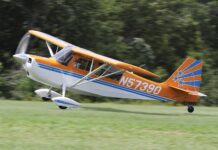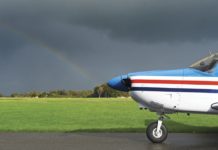Are you a proactive or reactive pilot? From our early primary training days, weve learned to fly by the airspeed indicator and listen for the stall warning horn when we venture too close to the lower edge of the planes airspeed envelope. Or, we live with the monotone blare while practicing the stall series. But what does it really tell us? Like other traditional primary instruments, there is some level of lag in

288
their indications, and the information we receive is delayed or incomplete.
Enter the angle of attack (AOA) indicator. While ubiquitous in gliders, where lift is life, chances are good your primary trainer did not have such instrumentation on board, although your training covered the concept of angle of attack.
AOA 101
Ah, stalls. During primary training, we memorize the aircrafts stall speeds, clean and dirty, in 1G flight. We are further admonished that the stall speed increases as the wing loading, as well as gross weight, increases. And then theres density altitude to consider. All these factors conspire to sabotage lift, and while the dissipation of lift has its place (such as right before touchdown), its better to be proactive in preserving lift than chasing its loss.
The angle of attack (the “alpha”) is the angle between the relative wind and the chord of the airfoil. (See the diagrams on the opposite page.)
All airfoils stall at a critical angle, typically between 10-15 degrees on light airplanes. Once you exceed that critical angle, the airfoil is stalled. The lift curve diagrams show that the wings lift increases as the AOA also increases until the airflow over the upper surface of the airfoil is disrupted, and the wings lift is destroyed.
Moreover, the wing can stall at any attitude, any airspeed and any bank angle. You can stall the airplane going straight down or straight up, and you can stall it in straight-and-level flight. Most vulnerable to this condition are the high-workload takeoff and approach phases of flight. High power, low altitude and low speed combine during takeoff to tax the pilots skill in controlling the plane, particularly if the departure airport is surrounded by obstacles. Approaches bring their own brand of criticality: Pilots uncomfortable with the low end of the envelope or concerned with gusts will tack on extra airspeed to stave off a potential stall, opening the door for porpoising or runway overruns. The NTSB accident files are fat with such occurrences.
And then there are base-to-final turns, which further fatten the NTSB database. Low-airspeed, low-altitude maneuvering combined with varying degrees of skill when executing the turn to final make aircraft control truly critical. And if you havent anticipated the timing of that turn correctly, overshooting the turn (particularly with parallel runways) can lead to an uncoordinated cross-controlled correction.
The skidded turn to a stall occurs when the pilot has overshot the centerline on final and, not wanting to exceed a 30-degree bank while turning to correct, he kicks in a little left rudder. The nose pokes below the horizon, the aircraft rolls a little to the left, and he compensates by inputting some right aileron to maintain the bank angle. Adding to the mlange of inputs, he pulls back on the yoke to sustain pitch attitude and feeds in some power to maintain airspeed. Lather, rinse, repeat…until the plane finally snap rolls inverted, and its all bad news from there. At 500 feet AGL, hes looking at an incipient spin if he holds the rudder in, or perhaps a split-S into the ground if he releases the rudder.
Before exploring the usefulness of an AOA indicator to avoid this no-win situation, its important to point out that a controlled overshoot of the runway centerline (providing it doesnt conflict with parallel landing traffic) is an acceptable alternative to the horror show just described. Too, leveling the wings and going around is always a good option, allowing you to fly another day. A third alternative is to increase your bank angle while increasing power, arresting the rate of descent and pitching slightly nose-down to stay above stall speed.
Sensing AOA
The traditional stall warning horn is a pretty good AOA indicator; it measures the AOA indirectly, and it will always go off at the same AOA. However, if youre approaching a critical angle at a high rate, which occurs when youre doing an accelerated (aerobatic) maneuver, by the time the horn sounds and you take some evasive action, you may have already stalled the airplane. The stall warning horn works well if youre not doing any accelerated maneuvers, because it will give you an adequate warning before stalling. A prime example of an aerobatic maneuver in a nonaerobatic airplane is the high-speed pass over the runway, followed by an abrupt pull-up.
Today, most primary instrumentation in GA aircraft doesnt directly indicate AOA. Instead, AOA instrumentation is placarded as advisory, and cannot be used as a primary flight indication. The information provided by a real-time AOA instrument will, however, reflect actual flight conditions with respect to gross weight, pitch, airspeed and other factors, and will allow you to adjust the inputs accordingly.
Two examples of AOA indicators are the AOA Sport and AOA Pro, intended for the experimental aircraft market, and now part of Oregon-based Advanced Flight Systems product line. The two products were developed by Jim Frantz, a 20,000-plus hour bush pilot, flight instructor and retired airline pilot.
Frantz became interested in this technology in the mid-1990s when he built a Lancair 360, a high-performance airplane with very light stick forces and high wing loading. He observed, “Its very easy to get the Lancair into an accelerated maneuver, and as with most high-performance airplanes, the stall characteristics are not benign. If you stall a high-performance airplane at or below pattern altitude, theres a good chance that you wont be able to recover from the stall before hitting the ground.”
Frantz felt that in such an aircraft, it was mandatory that he have something more than a traditional stall warning device, prompting him to develop the AOA instrument.
As Frantz explains, the AOA instrument allows you to continually and instantaneously monitor the AOA. If an airplane has a critical angle of, say, 13 degrees, as long as you keep it below 13 degrees, its impossible to stall the airplane. Once you reach 13 degrees, the airfoil is stalled, and you are no longer creating lift.
Can a pilot perceive his AOA by looking out the window? No. You cannot identify any correlation to the planes AOA by looking outside and noticing your attitude. The two factors comprising the critical angle-the chord of the wing and the relative wind-are invisible to the pilot.
Frantz doesnt sugar-coat it: “There are many less-experienced pilots that will argue the issue, and they are flat, dead wrong. There are also some old-timers who claim they can tell the AOA by how the wind whistles through the airplane, and they would also be dead wrong.”
As for training to use the device, Frantz says its intuitive, because once you get into the red, youre stalled. When youre in the yellow, youre approaching the critical angle, triggering the aural warning: “Angle, angle, push.”
“The aural warning is very important,” Frantz says, “because you may not have the AOA instrument in your peripheral vision. We recommend that the instrument be installed near the top of the instrument panel for that reason.”
Hickman notes, “Most customers purchase it as a stall warning device. Its real value is used in flying approaches and takeoffs. They dont just use airspeed-they crosscheck it if they fly the approaches using the instrument.” The doughnut in the middle of the display indicates the optimal approach to fly. “If you fly that, you get more consistent landings, slower approach speeds, and it will vary your approach speed based on gross weight. If the planes light, youll fly slower; if its heavy, youll fly faster. Traditional airspeed indicators wont show that.”
All the Advanced Flight Systems instruments use a patented wing pressure port technology to calibrate and calculate the critical angle. It also contains multiple databases for gear and flap configurations. The advanced EFIS display will also show best approach, best L/D max for best engine-out glide, best VY and an audio alert at 15 percent above stall.
Other Players
There are several other AOA systems to be found in all levels of general aviation aircraft, although the devices are usually aftermarket offerings, and are not certified as primary flight instruments. Meanwhile, TSOd AOA indicators are common equipment in corporate, commercial and certainly military aircraft, with price tags to match.
Developed in the 1970s, the Lift Reserve Indicator is from InAir Instruments of Westerville, Ohio. The company does not call it an angle of attack instrument, but does state that the LRI identifies the absolute stall angle for any aircraft. The LRI indicates how much reserve lift the plane has at any moment during flight, with an arced gauge with red, white and green segments, indicating mushy flight and minimal lift, adequate lift and lots of lift, respectively.
InAir Instruments estimates about four to 12 hours of shop time for installation, including about an hour for calibration. The LRI compensates for weight change during flight, and displays the changing amount of available lift as those conditions change. The calibration procedure is decidedly low-tech, involving a flight around the pattern, visually confirming the LRI reading when the plane fully stalls prior to landing with full up elevator.
Safe Flight of White Plains, N.Y., is perhaps the best-known and longest-lived player in the AOA indicator market. Until recently, the company offered its SC-150 system for single-engine aircraft. However, a vendor-supplied indicator component became unavailable about eight years ago, making it impossible to replace or repair. Safe Flights products have largely been geared toward corporate, commercial and government operations since then.
Tom Grunsbeck, Safe Flights senior V.P. of sales and marketing, returned from Octobers NBAA convention with news the companys lift transducer will be TSOd and integrated into Garmin Internationals G1000 display within the month. Dubbed a speed control feature, it integrates the primary stall warning system with the AOA instrument, using the green doughnut display to indicate flight at 1.3 VSO. An original-equipment announcement involving Safe Flight and the proverbial “aircraft manufacturer to be named later” is expected in the first quarter of 2009.
In our view, the move towards AOA awareness in the certified general aviation segment is long overdue. While the experimental aviation sector has had more freedom to develop and install these devices at a much lower cost than most piston-aircraft drivers, the certified sector is moving more surely towards adopting the technology. As personal airplanes continue to become faster, more complex and more highly automated-as well as more capable-reducing stall-related accidents through AOA instrumentation can only improve their overall safety.



